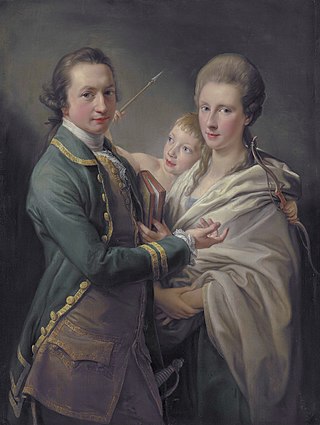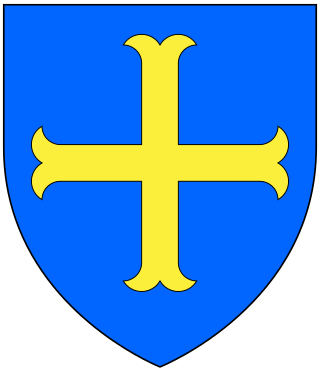
Colonel Sir John Burke, 2nd Baronet, DL was an Irish soldier and Whig politician who was MP for County Galway (1830–2) and High Sheriff of County Galway (1838–9).

Arthur Saunders Gore, 2nd Earl of Arran, KP, PC (Ire), styled The Honourable Arthur Gore from 1758 to 1762 and Viscount Sudley from 1762 to 1773, was an Irish peer and politician.
Sir Ralph Gore, 4th Baronet was a Speaker of the Irish House of Commons. He is now chiefly remembered for building Belle Isle Castle.

The Gethin Baronetcy, of Gethinsgrott in Cork, is a title in the Baronetage of Ireland. It was created on 1 August 1665 for Richard Gethin, who represented Clonmel and Newtown Limavady in the Irish House of Commons. The eighth Baronet was a Colonel in the British Army. Later generations added the name St. Lawrence, to indicate their connection to the Earl of Howth.

There have been three baronetcies created for descendants of the ancient Norman family of Molyneux who were granted extensive estates in Lancashire after the Norman Conquest.

John Fane, 9th Earl of Westmorland, known as Lord Burghersh until 1771, was an English peer and Member of Parliament.
Sir Thomas George Fermor-Hesketh, 5th Baronet was an English Conservative politician who sat in the House of Commons from 1862 to 1872.
Robert St Lawrence, 3rd Baron Howth was a leading nobleman and statesman in 15th-century Ireland who held the office of Lord Chancellor of Ireland. Through his second marriage, he was a close connection to the new Tudor dynasty, to which his son was staunchly loyal.
Nicholas St Lawrence, 4th Baron Howth was a leading Irish nobleman, soldier and statesman of the early Tudor period, who held the office of Lord Chancellor of Ireland.
The Sheriff of County Dublin was the Sovereign's judicial representative in County Dublin. Initially, an office for a lifetime, assigned by the Sovereign, the Sheriff became an annual appointment following the Provisions of Oxford in 1258. The first recorded Sheriff was Ralph Eure, appointed in that year. The next recorded Sheriff was Sir David de Offington, who was Sheriff in 1282. Besides his judicial importance, the sheriff had ceremonial and administrative functions and executed High Court Writs.
General Thomas William Fermor, 4th Earl of Pomfret, styled The Honourable Thomas Fermor until 1830, was an officer in the British Army who fought in the French Revolutionary and Napoleonic Wars.
Christopher St Lawrence, 5th Baron Howth (c.1485–1542) was an Anglo-Irish nobleman and statesman of the Tudor era.
Luke (Lucas) Netterville was a sixteenth-century Irish judge. He was father of the statesman Richard Netterville and grandfather of the 1st Viscount Netterville.
Lieutenant-Colonel Walter Sneyd, of Keele Hall was an English politician who served in the Parliament of Great Britain and as High Sheriff of Staffordshire.
Thomas St Lawrence, 1st Earl of Howth was Anglo-Irish peer and lawyer.
William St Lawrence, 14th Baron Howth (1688–1748) was an Irish peer and politician, who enjoyed the friendship of Jonathan Swift.

George Fludyer (1761–1837) was an English politician, the Member of Parliament for Chippenham from 1782 to 1802, and for Appleby from 1818 to 1819.

John Henry Fludyer, 4th Baronet (1803–1896), generally known as Henry Fludyer, was a baronet and clergyman who restored St Nicholas' Church in Thistleton, Rutland, as a memorial to his three eldest children. He inherited the baronetcy at a late age after his cousin and two elder brothers died without issue. He inherited the family seat at Ayston, a village where he was already rector, and near which he seems to have spent most of his life. He died at age 92, having been connected to the parish of Ayston for nearly 70 years.
William St Lawrence, 2nd Earl of Howth was an Anglo-Irish peer, styled Viscount St Lawrence from 1767 to 1801.






